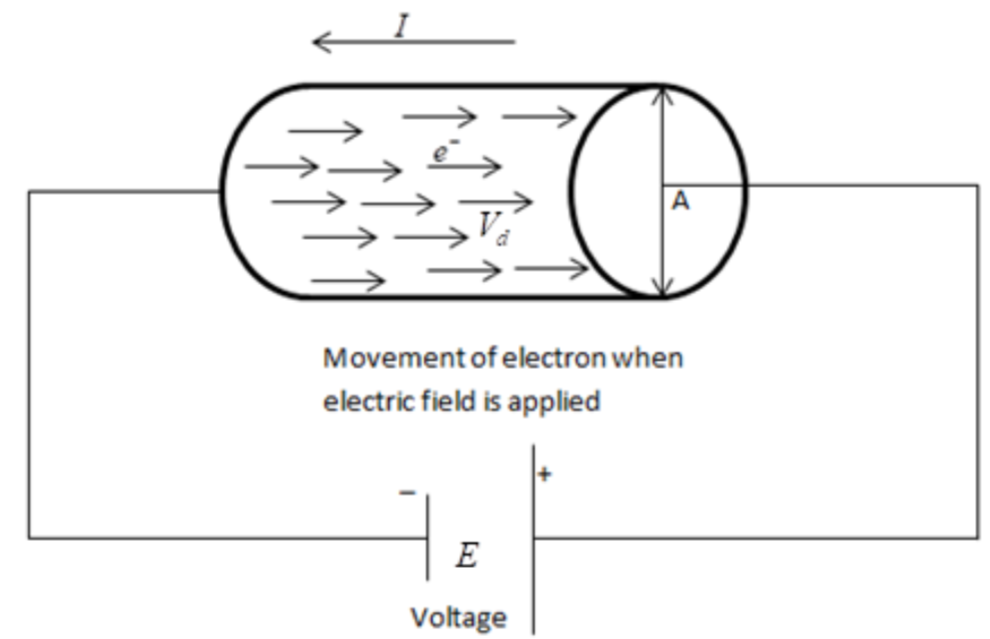
Define the term drift velocity of charge carriers in a conductor and write its relationship with the current flowing through it.
Answer
490.2k+ views
Hint: Drift velocity by the name itself suggests a velocity with which a particle is drifting in a certain direction. The velocity of electrons or particles depends upon the movement of particles. It is directly proportional to the current in the circuit.
Complete step-by-step answer:
For example, if we take up the case of an electron it is easier to understand. In normal conditions when no electrical potential is applied across a piece of wire, all the electrons move in random directions and in effect giving zero average velocity.
Let
$\mu $= mobility of charge carriers
${v_d} = $ Drift velocity
$\tau = $ Relaxation time
$q = $ Charge on charge carrier
Electric field
$m = $ Mass charge carrier.
Then, the drift velocity is given as-
Also, the relation between the drift velocity and electron mobility is given as
$\mu = \dfrac{{{v_d}}}{E}$
So now when we apply a potential to the piece of wire, still the electrons move in totally random directions but they have an added force acting on them due to the electric field applied which causes them to “drift” towards the side of the wire which is at a higher potential. So the net effect of this electric potential is that still the electrons move in random directions but now they also slowly move towards the higher potential side.
As we know the relation between the drift velocity and the current is given by
$I = - neA{v_d}$
Where I is the current, e is the electron, n is the number of charge, A is the area of cross-section and V is the drift velocity

The average velocity of the electrons is known as “Drift Velocity”.
Note: Drift velocity of electrons varies from one material to another , though it may seem as it is constant velocity at which electrons move under influence of electric field inside a conductor , whereas it is average velocity of accelerating electrons , which constantly collide with fellow atoms .
Complete step-by-step answer:
For example, if we take up the case of an electron it is easier to understand. In normal conditions when no electrical potential is applied across a piece of wire, all the electrons move in random directions and in effect giving zero average velocity.
Let
$\mu $= mobility of charge carriers
${v_d} = $ Drift velocity
$\tau = $ Relaxation time
$q = $ Charge on charge carrier
Electric field
$m = $ Mass charge carrier.
Then, the drift velocity is given as-
Also, the relation between the drift velocity and electron mobility is given as
$\mu = \dfrac{{{v_d}}}{E}$
So now when we apply a potential to the piece of wire, still the electrons move in totally random directions but they have an added force acting on them due to the electric field applied which causes them to “drift” towards the side of the wire which is at a higher potential. So the net effect of this electric potential is that still the electrons move in random directions but now they also slowly move towards the higher potential side.
As we know the relation between the drift velocity and the current is given by
$I = - neA{v_d}$
Where I is the current, e is the electron, n is the number of charge, A is the area of cross-section and V is the drift velocity

The average velocity of the electrons is known as “Drift Velocity”.
Note: Drift velocity of electrons varies from one material to another , though it may seem as it is constant velocity at which electrons move under influence of electric field inside a conductor , whereas it is average velocity of accelerating electrons , which constantly collide with fellow atoms .
Recently Updated Pages
Master Class 12 Economics: Engaging Questions & Answers for Success

Master Class 12 Maths: Engaging Questions & Answers for Success

Master Class 12 Biology: Engaging Questions & Answers for Success

Master Class 12 Physics: Engaging Questions & Answers for Success

Master Class 12 Business Studies: Engaging Questions & Answers for Success

Master Class 12 English: Engaging Questions & Answers for Success

Trending doubts
Who is Mukesh What is his dream Why does it look like class 12 english CBSE

Who was RajKumar Shukla Why did he come to Lucknow class 12 english CBSE

The word Maasai is derived from the word Maa Maasai class 12 social science CBSE

What is the Full Form of PVC, PET, HDPE, LDPE, PP and PS ?

Why is the cell called the structural and functional class 12 biology CBSE

Which country did Danny Casey play for class 12 english CBSE




